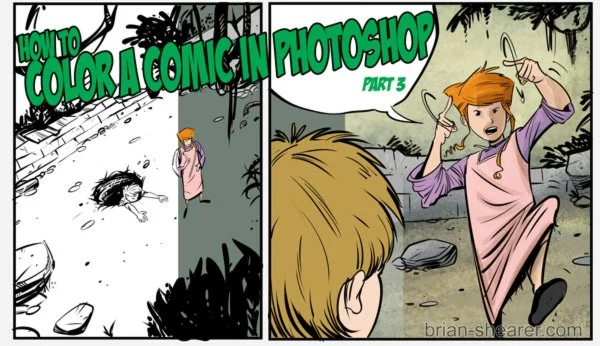HOW TO COLOR A COMIC IN PHOTOSHOP – Pt.3 SHADOWS AND HIGHLIGHTS
HOW TO COLOR A COMIC IN PHOTOSHOP – SHADOWS AND HIGHLIGHTS
Last time I went over how to color your comic with flat colors. This time I’ll go over some more fun stuff: rendering shadows and highlights.
So far you should have two layers — one for the lineart and one for the flat colors. Now we’re going to add two more layers. To be honest, I’m not sure how most people do this, but this is how I learned to do it and it’s worked for me. You can use this as a starting point and if you find a more efficient way that works for you, that’s great.
Before we go on, lock the flat color layer so you don’t accidentally color over the flats.
1) SETTING UP LAYERS
For this part, it’s important here that the flat color layer is highlighted. Just click on it once, then go up to the little button you used to create a new layer last time. Except now check the box that says “Use Previous Layer to Create Clipping Mask.”
Set the Mode to Multiply and then for good measure, rename the layer “shadows.” It should look like this:
Now we’re going to repeat all that again. With two differences. Highlight the layer you just created by clicking on it and then create a new layer. Once again check the “clipping mask” option and this time set the Mode to Screen. Rename this layer, “highlights.”
That’s all there is to setting things up.
2) TWO METHODS OF RENDERING
There are probably more than two ways of doing this, but here are two very common ones. First…
CUTS
In this method you use the lasso tool that you used to flat in last time. But now you’re going to use it to select areas to apply the darker or lighter colors.
Once you’ve decided which direction the light is coming from (in this case, our left) you want select the areas in shadow (or highlights) and slowly build up the levels of intensity. So here’s our first cut on the side of her face (out of context that sounds…weird.)
The multiply layer will be used for shadows, the screen layer will be used for highlights. Right now, let’s focus on the mulitply layer. Using the gradient tool (Click and hold the paint bucket tool to see the option for the gradient) set to a low opacity (say 20%, but it’s up to you) select a color (and this you’ll have to play with) to use for shadows. Even if you set your color to the same one you used for flats, the mulitply layer will make it darker.
TIP: When you select a tool on the toolbar, the options for that tool appear in the menu bar. For example below I’ve selected the pencil tool, but it works for the gradient tool, paint bucket tool, etc . The options I usually tweak are:
1: The Mode: Just like layers you can change what the brush does. Though I usually leave it on Normal.
2: The opacity of the brush. How much color will it lay down is determined here.
3: If you have a pressure sensitive tablet, this option makes the strokes respond to the pressure you put down with the stylus. The harder you press, the more opaque the color.
4: Like #3 above, this option responds to the tablet pressure, but instead makes the lines thinner or thicker depending on the pressure.
For any tool, this is where you can play with the options.
Once you have a color, you can click and drag the gradient tool in the direction you want and you get the section filled with shadow.
You can then re-select an area within that to layer a deeper shadows inside. Below I’ve made some quick cuts over the eyes, around the lips and on the shadow side of the nose.
From here you can decide how to lay out the shadows as they fall across the forms.
FREEHAND
Another way to do it is to select an area, either with the lasso tool, or the select the area of color in the flat layer with the magic wand (W on the keyboard) and use a pencil or brush set to a low opacity and build up colors. This is easier with some form of tablet in my experience. This is how I do my colors most of the time.
This method is a little more like coloring with traditional tools, at least that’s how I feel. You can also play with the opacity of a layer for more basic shading. You can also opt to do a simpler shadow/highlight method by just setting your opacity to 100% and using one solid color as a shadow with no gradient. I do this sometimes too, just depends on the project or scene. This is how a lot of animation is shaded these days.
For highlights, the technique is the same. Select the area and build up values, or do a flat highlight. Play with is and see what works.
You can also add more layers like you added the highlight and shadow layers…use as many as you need. And play with color dodge and color burn and see how they affect the flat colors. There are more ways to achieve your ends than I’ve presented here, but if you’re starting from scratch, the way I’ve outlined will get you familiar with how things work in Photoshop.
A good resource for understanding color and light and how they play out in different settings is James Gurney’s aptly titled book: Color and Light. Available on Amazon.
That’s all for now. Next time: Color and Texture overlays.





